


 |
April 17, 2018: A Stop in Goa, India |
 |
April 11, 2018: A Visit to Phuket, Thailand |
 |
Return to the Index for 2018 |
We will leave the ship today for a shore excursion here in Cochin (Kochi), India. The excursion will involve a bus tour of the city of Cochin, with stops at a Hindu Temple, an Art Gallery and Cafe (for lunch), St. Francis Church at Fort Kochi, and the Chinese Fishing Nets at Jawahar Park near Fort Kochi. This will be a six hour tour, and we should be back at the ship at around four this afternoon.
Docking in Cochin (Kochi), India
We have just come off three sea days in a row, and have arrived at the developing port of Cochin, India. Many maps spell the name of the city, the harbor, and the fort that began it all as Kochi, so if I happen to switch back and forth, the name's the same.
|
Anyway, I kind of like the sea days, for it gives us a chance to make some friends, play some bridge, explore the ship, and so on. And we've already made one good friend- Susan Sobieski- who is onboard with her husband and son. We met Susan for the first time in the card room as she saw us playing bridge and offered to sit in if we wanted. This allowed me to kibitz and help the other guys. I'll save more about Susan and her family for the page on life aboard the Mariner of the Seas, except to say that she lives not far from us in Florida, up in Deerfield Beach, and this means that if we can catch her in between cruises (she cruises a lot) we can get together when we are in Fort Lauderdale.
|
Cochin was not picturesque; it was very unlike stops in the Caribbean or the Mediterranean, or even places like Singapore. As is true of a number of cruise ship ports, it was in an industrial port area some distance from the city and the attractions that might be the destinations for shore excursions.
The harbor itself, and particular the cruise ship port, are under redevelopment, as Cochin is trying to become more of a tourist destination than it is now. So they are modernizing their facilities, but as of now, they are in the middle of all this, and the harbor area is less than attractive. If you add that to the fact that while the dock is only a mile or so from Cochin itself or from Fort Kochi (one of the areas tourists want to see), the port is on an island (see the aerial image, on which I've marked some of our own excursion destinations with yellow stars), and the accesses to either the mainland or to the island on which Fort Kochi is located are way to the south- much too far to walk. So, as is also true of other ports in areas like this, one either has to be on an excursion or has to take a shuttle to a point where taxis are available.
|
After breakfast, we did indeed meet up with our tour group in the theatre, and by nine in the morning we were off the ship and on the dock, being led to our particular bus. On the way, Fred took this picture of the Mariner of the Seas.
Ernakulam Shiva Temple Complex
We boarded our tour bus at the dock and headed off on our tour around Cochin. We took lots of pictures from the bus, but I'm going to put all of them into the next section on this page. For now, we'll stop at the Hindu Temple complex of Ernakulam Shiva Kshetra- on the mainland in the middle of town. Our bus parked just outside the entrance to the complex (although we found out shortly that there were a couple of other ways in and out of the temple area.
|
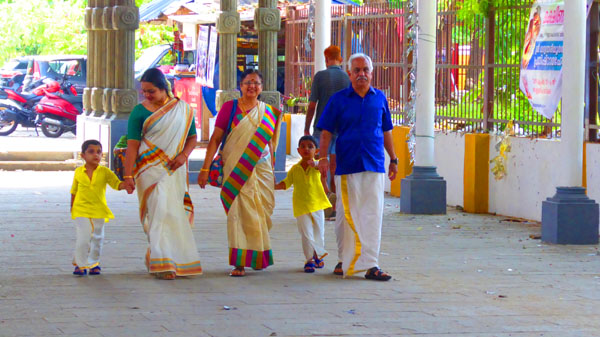
As we would discover, there were actually three separate temples inside the complex, and we'll take a look at each one in a moment. But there were two interesting aspects just to wandering around. One was the wide variety of dress the locals displayed; some almost made me think they were there for people to photograph.
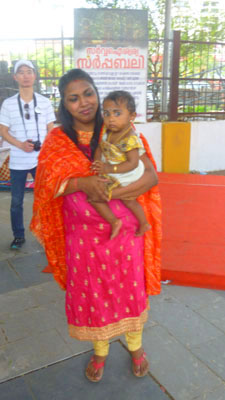 Mother and Child Reunion |
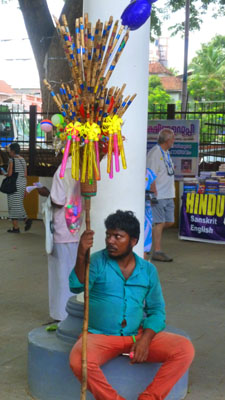 For Offerings in the Temples |
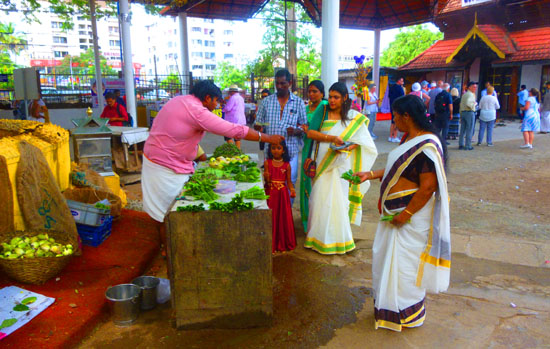 Buying Small Offerings |
And before we look at each of the three temples, here are a couple of general movie made here in the complex. The first looks at the entrance opposite the one at which we entered, and the other looks 360° around the complex (and features our male tour guide at the end).
|
(Mouseover Image Above for Video Controls) |
(Mouseover Image Above for Video Controls) |
Now let's take a look at the individual temples here in the complex.
The Sree Hanuman Kovil Temple
|
Here are some more good views of this temple, including closeups of the carvings above the entrance:
|
Across from the Sree Hanuman Kovil is the Ernakulam Shiva Temple- the first temple built here in the complex.
Ernakulam Shiva Temple
|
|
In 1843, the Diwan of Kochi, Sri Edakkunni Sankara Warrier, began a major renovation of the temple, and the new temple complex was opened to the public in 1846. The temple was re-elevated to a royal temple and brought under the direct administration of Kochi Government, moving to Kerala State control when Kochi joined India Union in 1949. More recently, additional land was purchased, and the transition from a single temple to a temple complex was accomplished.
We had a look at this temple as soon as we entered the complex, and then came back to it for more pictures towards the end of our visit- including one I was able to get of all the shoes left at the entrance- seemingly deserted what with nobody around. (And a lot of them looked the same, making me wonder how careful everyone is to reclaim their own.)
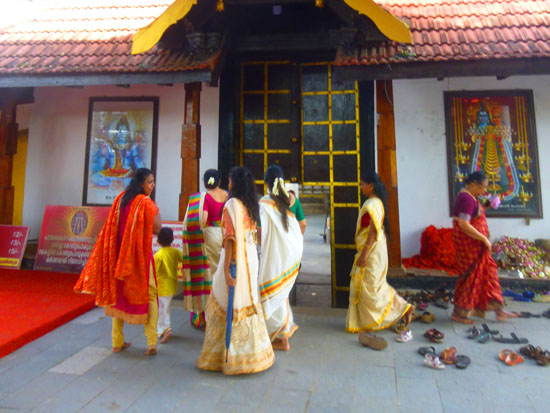 Indian Women Entering the Temple |
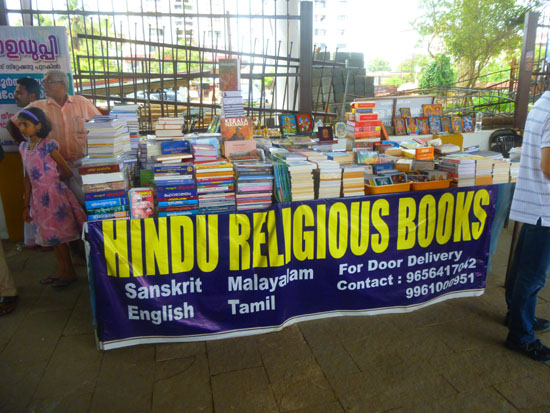 And to Learn More About Hinduism... |
The Murugan Kovil
|
Dravidian architecture is a type of Hindu temple architecture that emerged in South India, and which reached its final form by the sixteenth century. It consists primarily of Hindu temples where the dominating feature is the high gopura or gatehouse; large temples have several. The majority of structures in this style that still exist are located in five Southern Indian states- including Kerala, the state in which Cochin is located. Various kingdoms and empires such as the Cholas (who had their own variant known as the "Chola style") and the Chera have made substantial contribution to the evolution of Dravidian architecture. This style of architecture can also be found in parts of North India and in Sri Lanka.
|
Besides these elements, a South Indian temple usually has a tank used for sacred purposes or the convenience of the priests, dwellings for all the grades of the priesthood, and other buildings for state functions or convenience.
The version of Dravidian architecture found in Kerala in the far south-west is significantly different. Very large temples are rare, and sloping roofs with projecting eaves dominate the outline, often arranged in a number of tiers. As in Bengal, this is an adaption to the heavy monsoon rainfall. There is usually a stone core below a timber superstructure. The architecture of Kerala goes back to the Chera dynasty in the 12th century, and a variety of ground plans have been used, including circular ones. The development of multi-building complexes like this one came relatively late.
|
The temple complex was very interesting, although I know very, very little about Hinduism or about the history of India. Our guide certainly seemed to, but of course, he was both a Hindu and Indian. He eventually got us back in our bus and we headed off towards Fort Kochi.
Driving Through Cochin City
We did a fair amount of riding in our tour bus today- from the dock to the temple complex, from there to lunch and Jawahar Park and from there back to the ship. So that I can focus each group of pictures on the individual stops we made or sites that we saw, I want to aggregate in this section all the pictures we took from the bus as we drove along.
|
It was a sleepy Sunday, and the streets were not particularly busy in the city itself, but on the narrow streets of Kochi's island there were lots of people out and about, and lots of traffic as well. (I would not have wanted to drive a tour bus down those streets, but our driver was pretty expert.) And all along the way, I should compliment our tour guide for keeping up a running commentary all along the way.
So in this section will be all the interesting pictures we took from the bus. Many of them didn't turn out well, either because of reflections on the windows, the jostling of the bus, or the simple fact that we were moving and trying to compose pictures at the same time. Quite a few turned out to be uninteresting, and I've eliminated those. Each picture I've chosen shows something interesting, typically Indian or typical of Cochin, or (and a lot of them fall into this category) humorous in some way. An example of the latter is this picture of a modern house juxtaposed with a clothes line and a pile of broken bricks and tile on the other side of their wall.
|
|
And below is the single good movie that I took looking out the front window of our bus:
|
(Mouseover Image Above for Video Controls) |
I hope you found the candid city views of Cochin interesting; certainly we did. Cochin was absolutely unlike anyplace we have been, and as a matter of fact the only place I can compare it to in my own experience was Seoul in 1970. So, if you've already looked at the pages for our trip to Seoul, and you've read my comments that so much had changed, then just substitute these pictures for those of the "Old Seoul".
Lunch at the David Hall Gallery
As you can see from the aerial view above (the one with our route marked on it), we'll be spending most of our tour here at the northern tip of the island/peninsula- the site of Fort Kochi. The first place we stopped was at David Hall (which I originally and mistakenly thought was a person) Gallery. Fred got a good picture of me outside the gallery.
|
A "Renaissance Man", Van Rheede brought together a large collection of plants in the garden of the company, probably laying the seeds for the Hortus Malabaricus, a comprehensive volume on the flora of Kerala, with emphasis on their medical properties. The ethno-medical information presented in Hortus Malabaricus was extracted from palm-leaf manuscripts maintained by a Kerala native who was introduced to Henrik van Rheede by Veera Kerala Varma- the then ruler of the erstwhile state of Kochi. The book was compiled with the help of a team of nearly a hundred local and foreign residents under the tutelage of Varma's horticulturist, who thoroughly searched the region for specimens. These specimens were brought to Cochin, where a Carmelite named Mathaeus sketched them. The book brought under its mission physicians, professors of medicine and botany, amateur botanists, illustrators, engravers and clergymen. In fact, in return for the help offered by the latter, Van Rheede gave permission for erecting churches. The Chathiat Mouth Carmel Church was constructed on such an agreement in 1673.
|
Today, the beautiful ancient bungalow, a shared legacy of India and the Netherlands, has been restored by CGH Earth and the Netherlands Culture Administration to take on a new life as a cultural center with a gallery for contemporary art, with a focus on roviding a platform fo ryoung artists. With its cafe and space fo rperforming arts, the historic building has become an inspiring, vibrant meeting place for fresh talent and lovers of art.
Out in the patio courtyard we were served a light lunch (sandwiches and sweets) and something to drink; this was one of the few shore excursions we've been on that extended across a mealtime but which didn't include that meal. Even so, all we'd been doing is just a bit of walking, so I don't know that anyone was really famished. One of the sweets, we were told, was made from the fruit of the Jackfruit tree- a tree that I, at least, had not heard of. We were directed by our guide to a tree at the back of the patio and we went over to examine it. It was certainly unusual.
|
Jackfruit is commonly used in South and Southeast Asian cuisines. The ripe and unripe fruits are used, as are the seeds. The jackfruit tree is a widely cultivated and popular food item throughout the tropical regions of the world. It is the national fruit of Bangladesh and Sri Lanka and the state fruit of Kerala, where we are now. In fact, Kerala State is the largest producer of jackfruit in the world.
The fruit's flavor is comparable to a combination of apple, pineapple, mango, and banana and is naturally sweet. It can be used to make a variety of dishes, including custards, cakes, or mixed with shaved ice as a refreshing dessert. Mixed with rice, it is a traditional breakfast dish in southern India, and the leaves are used as a wrapping for steaming. One of our little cakes had jackfruit mixed into the batter. You can also buy little bags of dried jackfruit chips. The seeds are edible and are often compared to Brazil nuts when ripe and to chestnuts when they are roasted; the dried, roasted, salted seeds are a common snack, and they often appear in curries in India- particularly in lentil and vegetable curries. As you can see, the fruit has many uses. I, myself, thought the flavor of the cake was something like a cross between carrot cake and banana bread.
|
If you would like to see some of the artwork, you can have a look at some of the pictures we took as we wandered around the display spaces:
|
When everyone was done, our guide led us back outside and a block or so up the road to the St. Francis Church- our next stop. I noticed an interesting building across the street, and asked Fred to get in a couple of pictures of it:
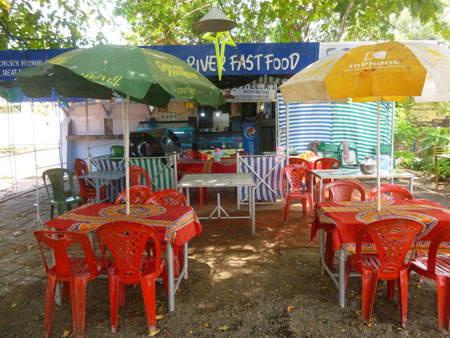 Not Exactly McDonalds |
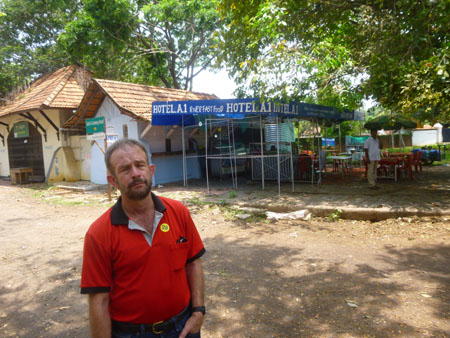 Not a Hotel Dining Room, Either |
St. Francis Church
Walking a couple of block further north, we crossed to the other side of the street to have a look inside the St. Francis Church.
|
|
The Raja of Cochin allowed Francisco de Almeida, the Portuguese viceroy, to reconstruct wooden buildings within the fort using stone and masonry. The wooden St. Bartholomew church was rebuilt, presumably by the Franciscan friars, with bricks and mortar and a tiled roof was erected. In 1516, the new church was completed and it was dedicated to St. Anthony.
|
In 1795, the British captured Kochi from the Dutch but they allowed the latter to retain the church. In 1804, the Dutch voluntarily handed over the church to the Anglican Communion. It was placed under the Ecclesiastical Department of the Government of India. It is believed that the Anglicans changed the name of the patron saint to St. Francis.
In 1923, the government of India declared the church to be a protected monument. This means that the Church is maintained under the auspices of the Archaeological Survey of India but is actually owned by the Kochi diocese of Church of South India. It has services on Sundays and commemorative days. On weekdays it is kept open for visitors like us.
As I said above, Vasco da Gama was originally buried in this church, but his remains are no longer here. Along the right side of the nave was a sign indicating where da Gama's tomb had been. There were also some other tomb markers here in the church:
 |
 |
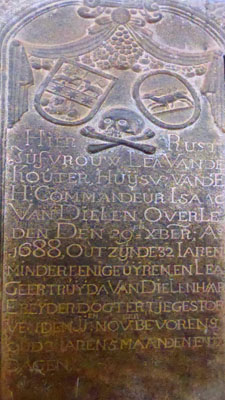 |
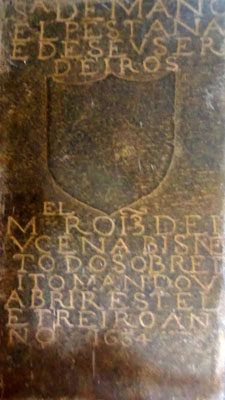 |
At the back of the nave there was a carved wooden item that neither Fred nor I could identify; perhaps you can, and if so, I would appreciate an email at website at rondougherty dot com. Here are two final pictures of the inside of St. Francis Church:
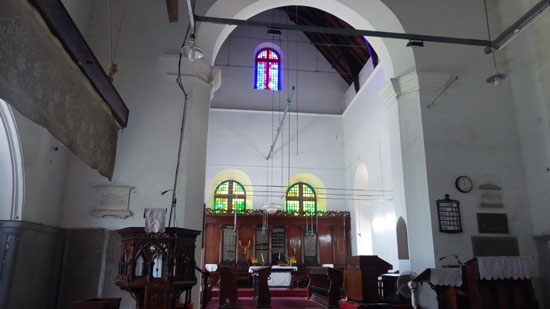 Altar/Sacristy |
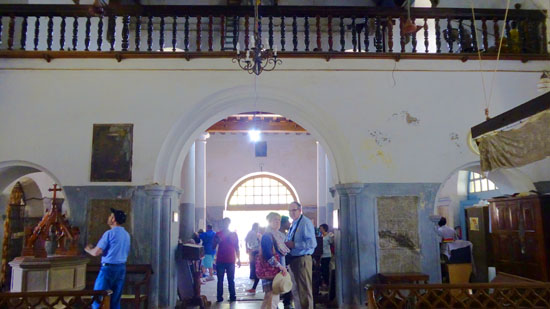 The Rear of the Nave |
Jawahar Park and the Chinese Nets
Jawahar Park is a green area at the northwest tip of Fort Kochi. The main feature of the park is the long paved street along which numerous vendors have set up their stalls- selling everything from fresh produce to souvenirs. On the whole, the park is well-maintained, although there are so many people that keeping it that way has to be difficult. The entire area is shaded by large old trees, and while most people stroll along past the kiosks, there are a few places where folks can sit and relax or watch the other people go by. The park is adjacent to the stop that our tour made at the Chinese Fishing Nets, and there were also a number of cafes and refreshment stands.
We took quite a few pictures as we walked through the park, and I have put a selection of them into a slideshow (below, left). As with all the slideshows on these pages, use the little arrows in the lower corners of each picture to go from one to the next, and use the index numbers in the upper left to track your progress.
|
|
|
(Mouseover Image Above for Video Controls) |
The reason for walking through the park (located just north of St. Francis Church) was to get to the shore of this peninsula where our tour would stop for a demonstration of "the Chinese fishing nets". We had seen many Chinese fishing nets earlier today as we were crossing some of the bridges from island to island on our shore excursion, but now we would get a chance to see them and their operation up close. Here is the shoreline where we stopped for our demonstration:
|
Chinese fishing nets are a type of stationary lift net used in India; they are fixed land installations. While commonly known as "Chinese fishing nets" in India, the more formal name for such nets is "shore operated lift nets". Huge mechanical contrivances hold out horizontal nets that are 60 feet or more avross.
|
This way of fishing is actually unusual elsewhere in India; it is found here because the area now known as Kerala State was where the Chinese explorers landed in the 14th century. Indeed, one interpretation of the city name Kochi is "co-chin", meaning "like China."
The system is sufficiently balanced so that the weight of a single man walking along the main beam is sufficient to cause the net to descend into the sea. The net is left for a short time, sometimes just a few minutes, before it is raised by pulling on ropes. The catch is usually modest: a few fish and crustaceans, which may be sold to passers-by immediately.
The large rocks are suspended from ropes of different lengths. As the net is raised, some of the rocks one-by-one come to rest on a platform thereby keeping everything in balance. Each installation has a limited operating depth. Consequently, an individual net cannot be continually operated in tidal waters, and so you will usually see a series of installations at different heights.
The Chinese fishing nets have become a very popular tourist attraction. Their size and elegant construction is photogenic and the slow rhythm of their operation is quite hypnotic. In addition, catches can be purchased individually and need be taken only a short distance to a street entrepreneur who will cook them (not a convenience of which we availed ourselves).
Fred took two more excellent pictures here at the shore:
|
|
From the Chinese fishing nets, we returned to our tour bus and from Fort Kochi made our way back to the Mariner of the Seas, bringing our visit to Cochin, India, to an end.
You can use the links below to continue to another photo album page.
 |
April 17, 2018: A Stop in Goa, India |
 |
April 11, 2018: A Visit to Phuket, Thailand |
 |
Return to the Index for 2018 |